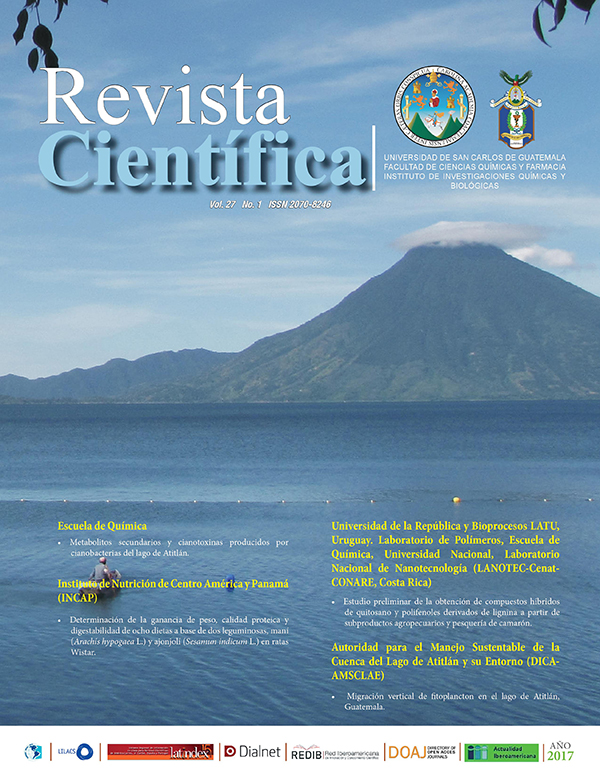Determination of weight gain, protein quality and digestibility of eight diets based on two legumes, peanut (Arachis hypogaea L.) and sesame (Sesamum indicum L.) in Wistar rats
DOI:
https://doi.org/10.54495/Rev.Cientifica.v27i1.73Keywords:
seeds, protein, nutrition, macronutrients, micronutrientsAbstract
Peanuts and sesame are two important sources of macronutrients and micronutrients. The objectives of this study were to evaluate the weight gain, protein quality and digestibility of eight legume-based diets in Wistar rats during a period of four weeks. The diets were classified as: control diet, diet A (skim milk), diet B (nitrogen free), diets C, D, E, F (with peanuts in a proportion that varied from 100%, 75%, 50% to 25%, mixed with skim milk), diets G, H, I, J (with sesame in a proportion that varied from 100%, 75, 50% to 25%, mixed with skim milk). The study showed significant differences in weight gain when comparing with the control diet, particularly with diet D (75% peanut) with 226 g (SD=55.29) (p<0.05), diet H (75% sesame) with 218.16 g (SD=56.28) (p<0.05), and diet I (50% sesame) with 216.83 g (SD=45.86) (p<0.05). The study showed that the diets with skim milk and legumes were highly digestible (96% - 100%), with protein efficiency ratio (PER) of 2.73, very similar to the control diet. These formulations are promising and have potential implications for human nutrition.
Downloads
References
Alid G., Yanez E., Aguilera J., Monckeberg F., & Chichester C. (1981). Nutritive value of an extrusion texturized peanut protein. Journal of food Science, 46(3), 948-949. https://doi.org/10.1111/j.1365-2621.1981.tb15390.x DOI: https://doi.org/10.1111/j.1365-2621.1981.tb15390.x
Arimond, M., Zeilani, M., Jungjohann, S., Brown, K. H., Ashorn, P., Allen, L. H., … Dewey, K. G. (2015). Considerations in developing lipid-based nutrient supplements for prevention of undernutrition: experience from the International Lipid-Based Nutrient Supplements (iLiNS) Project. Maternal & Child Nutrition, 11(4), 31-61. https://doi.org/10.1111/mcn.12049 DOI: https://doi.org/10.1111/mcn.12049
Bressani, R. (2010). Studies of vegetable proteins for human consumption. Food and Nutrition Bulletin, 31(1), 95-110. https://doi.org/10.1177/156482651003100110 DOI: https://doi.org/10.1177/156482651003100110
Dardon J. & Bressani, R. (2012). Evaluación de la calidad nutritiva del maíz QPM en la ganancia de peso de ratas Wistar (Tesis de licenciatura). Universidad Rafael Landivar, Guatemala.
De Souza, N., Elias, L. G., & Bressani, R. (1970). Studies in rats of the effect of a basic rural Guatemalan diet supplemented with cow’s milk and a protein mixture. Archivos. Latinoamericanos de Nutricion, 20(3) 293-307.
Dreyer, J. J. (1968). Biological assessment of protein quality: digestibility of the proteins in certain foodstuffs. South African medical. journal, 42(48), 1304-13.
Hackler, L. R., (1979). Methods of measuring protein quality: a review of bioassay procedure. Journal Cereal Chemist, 54(5), 984-995.
Jacoby, R. O., & Lindsey, J. R. (1998). Risks of infection among laboratory rats and mice at major biomedical research institutions. Journal National Research Council, Institute of Laboratory Animal Resources, 39(4), 266-271. https://doi.org/10.1093/ilar.39.4.266 DOI: https://doi.org/10.1093/ilar.39.4.266
Joseph, A. A., Tasker, P. K., Kantha, J., Narayana Rao, M., Swaminathan, M., Sankaran, A. N., … Subrahmanyan, V. (1962). La utilización neta de proteínas y la relación de eficiencia proteica de
sseame proteínas suplementadas con lisina a los niveles presentes en el patrón de proteína de referencia de la FAO y la leche. Anales de Bioquímica y Medicina Experimental, 22(5), 113-116.
McDonough, F. E., Steinke, F. H., Sarwar, G., Eggum, B. O., Bressani, R., Huth, P. J., … Phillips, J. G. (1990). In vivo rat assay for true protein digestibility: collaborative study. Journal Association of Official Analytical Chemists, 73(5), 801-805. https://doi.org/10.1093/jaoac/73.5.801 DOI: https://doi.org/10.1093/jaoac/73.5.801
Rivas, J. (2014). Determinación nutricional y calidad proteica de dietas a base de maíz y frijol complementadas con tres plantas autóctonas de Guatemala (chipilín, hierbamora y bledo). (Tesis de licenciatura). Universidad Rafael Landivar, Guatemala.
Rodas, B. & Bressani, R. (2009). The oil, fatty acid and squalene content of varieties of raw and processed amaranth grain. Archivos Latinoamericanos de Nutrición, 59(1), 82-7.
Sarwar, G., Peace, R. W., Botting, H. G., & Brul, D. (1989). Relationship between amino acid scores and protein quality indices based on rat growth. Plant Foods for Human nutrition. 39(1), 23-32. https://doi.org/10.1007/BF01092398 DOI: https://doi.org/10.1007/BF01092398
Sen M. & Bhattacharyya DK. (2001). Nutritional quality of sesame seed protein fraction extracted with isopropanol. Journal of Agricultural and Food Chemistry, 49(5), 2641-2446. https://doi.org/10.1021/jf001004q DOI: https://doi.org/10.1021/jf001004q
Singh, B. & Singh , U. (1991.). Peanut as a source of protein for human foods. Plant Foods for Human nutrition. 41 (2), 165-177. https://doi.org/10.1007/BF02194085 DOI: https://doi.org/10.1007/BF02194085
Snyderman, S. E., Holt, L. E., & Boyei, A. (1960). Amino acid reference patterns: a comparison of the pattern of human milk with the fao pattern in human nutrition. The Journal of Nutrition. 72(4), 404-408. https://doi.org/10.1093/jn/72.4.404 DOI: https://doi.org/10.1093/jn/72.4.404
Suckow M, Weisbroth S., & Craig L. (2006). The Laboratory Rat. Burlinton:Elsevier.
World Health Organization, Food and Agriculture Organization of the United Nations, United Nations University. (2007). Protein and amino acid requirements in human nutrition (Technical Report Series 935). Geneva: Autor.
United States Department of Agriculture. (2016). Food Composition [versión virtual]. Recuperado de https://ndb.nal.usda.gov/ndb/
Downloads
Published
How to Cite
Issue
Section
License
Copyright (c) 2017 Miguel Cuj, Jessica Dardón de Richardson, Manolo Mazariegos, Wilton Pérez Corrales, Edward Fischer, y Ana Victoria Román Trigo

This work is licensed under a Creative Commons Attribution 4.0 International License.
Authors who publish with this journal agree to the following terms:
- Authors retain copyright and grant the journal right of first publication with the work simultaneously licensed under a Creative Commons Attribution License 4.0 that allows others to share the work with an acknowledgement of the work's authorship and initial publication in this journal.
- Authors are able to enter into separate, additional contractual arrangements for the non-exclusive distribution of the journal's published version of the work (e.g., post it to an institutional repository or publish it in a book), with an acknowledgement of its initial publication in this journal.
- Authors are permitted and encouraged to post their work online (e.g., in institutional repositories or on their website) prior to and during the submission process, as it can lead to productive exchanges, as well as earlier and greater citation of published work.









